Towards an Assessment of the Ephemeral Gully Erosion Potential in Greece Using Google Earth
Abstract
1. Introduction
2. Materials and Methods
- Curved or straight linear segments inside agricultural fields, darker or lighter from their surroundings.
- Presence of natural vegetation along with linear features, either meeting or not the drainage network.
- Number of ephemeral gullies
- Exact flow path of ephemeral gullies
- Length of every ephemeral gully (in meters)
- Averaged elevation (in meters)
- Averaged slope degree (in %)
- Signs and grade of rills
- Signs and grade of sheet erosion
- All land use categories (with visual interpretation on Google Earth)
- The number of the GE images covering the sampled surface
3. Results
3.1. Descriptive Statistics
3.2. Geographic Distribution
3.3. Geostatistical Analysis
3.4. Gully Erosion Trends in Relation to Land Use and Topography
- Length vs. number of gullies (mostly negative)
- Number of gullies vs. slope (mostly positive)
- Total length of gullies vs. slope (mostly negative)
- Severity of sheet erosion sings vs. elevation (positive)
3.5. Gully Erosion Correlation with Drainage Network
4. Discussion
5. Concluding Remarks
Author Contributions
Funding
Acknowledgments
Conflicts of Interest
References
- Vanmaercke, M.; Poesen, J.; Verstraeten, G.; de Vente, J.; Ocakoglu, F. Sediment yield in Europe: Spatial patterns and scale dependency. Geomorphology 2011, 130, 142–161. [Google Scholar] [CrossRef]
- Soil Science Society of America, Glossary of Soil Science Terms; Soil Science Society of America: Madison, WI, USA, 2001; Available online: http://www.soils.org/sssagloss/ (accessed on 8 February 2020).
- Castillo, C.; Gómez, J.A. A century of gully erosion research: Urgency, complexity and study approaches. Earth-Sci. Rev. 2016, 160, 300–319. [Google Scholar] [CrossRef]
- Poesen, J.; Nachtergaele, J.; Verstraeten, G.; Valentin, C. Gully erosion and environmental change: Importance and research needs. Catena 2003, 50, 91–133. [Google Scholar] [CrossRef]
- Verstraeten, G.; Poesen, J. The nature of small-scale flooding, muddy floods and retention pond sedimentation in central Belgium. Geomorphology 1999, 29, 275–292. [Google Scholar] [CrossRef]
- Ionita, I.; Fullen, M.A.; Zgłobicki, W.; Poesen, J. Gully erosion as a natural and human-induced hazard. Nat. Hazards 2015, 79, S1–S5. [Google Scholar] [CrossRef]
- Foster, G.R. Understanding ephemeral gully erosion. In Soil Conservation: Assessing the National Resources Inventory; National Academy Press: Washington, DC, USA, 1986; Volume 2, pp. 90–118. [Google Scholar]
- Casali, J.; Bennett, S.J.; Robinson, K.M. Processes of ephemeral gully erosion. Int. J. Sediment Res. 2000, 15, 31–41. [Google Scholar]
- Bennett, S.J.; Wells, R.R. Gully erosion processes, disciplinary fragmentation, and technological innovation. Earth Surf. Process. Landf. 2019, 44, 46–53. [Google Scholar] [CrossRef]
- Valentin, C.; Poesen, J.; Li, Y. Gully erosion: Impacts, factors and control. Catena 2005, 63, 132–153. [Google Scholar] [CrossRef]
- Frank, A.; Nyssen, J.; De Dapper, M.; Haile, M.; Billi, P.; Munro, R.N.; Deckers, J.; Poesen, J. Linking long-term gully and river channel dynamics to environmental change using repeat photography (Northern Ethiopia). Geomorphology 2011, 129, 238–251. [Google Scholar] [CrossRef]
- Gordon, L.M.; Bennett, S.J.; Alonso, C.V.; Bingner, R.L. Modeling long-term soil losses on agricultural fields due to ephemeral gully erosion. J. Soil Water Conserv. 2008, 63, 173–181. [Google Scholar] [CrossRef]
- Bingner, R.L.; Wells, R.R.; Momm, H.G.; Rigby, J.R.; Theurer, F.D. Ephemeral gully channel width and erosion simulation technology. Nat. Hazards 2016, 80, 1949–1966. [Google Scholar] [CrossRef]
- Vanmaercke, M.; Poesen, J.; Van Mele, B.; Demuzere, M.; Bruynseels, A.; Golosov, V.; Bezerra, J.F.R.; Bolysov, S.; Dvinskih, A.; Frankl, A.; et al. How fast do gully headcuts retreat? Earth-Sci. Rev. 2016, 154, 336–355. [Google Scholar] [CrossRef]
- Capra, A.; Mazzara, L.M.; Scicolone, B. Application of the EGEM model to predict ephemeral gully erosion in Sicily, Italy. Catena 2005, 59, 133–146. [Google Scholar] [CrossRef]
- Rundquist, B.C. The influence of canopy green vegetation fraction on spectral measurements over native tallgrass prairie. Remote Sens. Environ. 2002, 81, 129–135. [Google Scholar] [CrossRef]
- Hessel, R.; Van Asch, T.W.J. Modelling gully erosion for a small catchment on the Chinese Loess Plateau. Catena 2003, 54, 131–146. [Google Scholar] [CrossRef]
- de Roo, A.; Jetten, V.; Wesseling, C.; Ritsema, C. LISEM: A physically-based hydrologic and soil erosion catchment model. In Modelling Soil Erosion by Water; Springer: Berlin/Heidelberg, Germany, 1998; pp. 429–440. Available online: https://link.springer.com/chapter/10.1007/978-3-642-58913-3_32 (accessed on 10 February 2020).
- Nwakwasi, N.L. Modelling of Gully Erosion Site Data in Southeastern Nigeria, Using Poisson and Negative Binomial Regression Models. J. Civ. Constr. Environ. Eng. 2018, 3, 111–117. [Google Scholar] [CrossRef]
- Zabihi, M.; Mirchooli, F.; Motevalli, A.; Darvishan, A.K.; Pourghasemi, H.R.; Zakeri, M.A.; Sadighi, F. Spatial modelling of gully erosion in Mazandaran Province, northern Iran. Catena 2018, 161, 1–13. [Google Scholar] [CrossRef]
- Domazetović, F.; Šiljeg, A.; Lončar, N.; Marić, I. GIS automated multicriteria analysis (GAMA) method for susceptibility modelling. MethodsX 2019, 6, 2553–2561. [Google Scholar] [CrossRef]
- Panagos, P.; Borrelli, P.; Poesen, J.; Ballabio, C.; Lugato, E.; Meusburger, K.; Montanarella, L.; Alewell, C. The new assessment of soil loss by water erosion in Europe. Environ. Sci. Policy 2015, 54, 438–447. [Google Scholar] [CrossRef]
- Panagos, P.; Karydas, C.G.; Gitas, I.Z.; Montanarella, L. Monthly soil erosion monitoring based on remotely sensed biophysical parameters: A case study in Strymonas river basin towards a functional pan-European service. Int. J. Digit. Earth 2012, 5, 461–487. [Google Scholar] [CrossRef]
- Panagos, P.; Karydas, C.; Ballabio, C.; Gitas, I. Seasonal monitoring of soil erosion at regional scale: An application of the G2 model in Crete focusing on agricultural land uses. Int. J. Appl. Earth Obs. Geoinf. 2014, 27, 147–155. [Google Scholar] [CrossRef]
- Kazamias, A.P.; Sapountzis, M. Spatial and temporal assessment of potential soil erosion over Greece. Water 2017, 59, 315–321. [Google Scholar]
- Evelpidou, N.; Vassilopoulos, A.; Leonidopoulou, D.; Poulos, S. An investigation of the coastal erosion causes in Samos Island, Eastern Aegean Sea. J. Landsc. Ecol. 2008, 6, 295–310. [Google Scholar]
- Andredaki, M.; Georgoulas, A.; Hrissanthou, V.; Kotsovinos, N. Assessment of reservoir sedimentation effect on coastal erosion in the case of Nestos River, Greece. Int. J. Sediment Res. 2014, 29, 34–48. [Google Scholar] [CrossRef]
- Borrelli, P.; Panagos, P.; Ballabio, C.; Lugato, E.; Weynants, M.; Montanarella, L. Towards a pan-European assessment of land susceptibility to wind erosion. Land Degrad. Dev. 2016, 27, 1093–1105. [Google Scholar] [CrossRef]
- Nemes, I.; Constantinescu, L. The Gully Erosion Effect on the Environment. In Proceedings of the International Conference on Information and Communication Technologies for Sustainable Agri-Production and Environment (HAICTA 2011), Skiathos, Greece, 8–11 September 2011. [Google Scholar]
- Vandekerckhove, L.; Poesen, J.; Oostwoudwijdenes, D.; Nachtergaele, J.; Kosmas, C.; Roxo, M.J.; De Figueiredo, T. Thresholds for gully initiation and sedimentation in Mediterranean Europe. Earth Surf. Process. Landf. 2000, 25, 1201–1220. [Google Scholar] [CrossRef]
- Gilad, U.; Denham, R.; Tindall, D. Gullies, Google Earth and the Great Barrier Reef: A remote sensing methodology for mapping gullies over extensive areas. International Archives of the Photogrammetry. In Proceedings of the International Archives of the Photogrammetry, Remote Sensing and Spatial Information Science, XXII ISPRS Congress, Melbourne, Australia, 25 August–1 September 2012; Available online: https://www.int-arch-photogramm-remote-sens-spatial-inf-sci.net/XXXIX-B8/469/2012/ (accessed on 10 February 2020).
- Boardman, J. The value of Google Earth ™ for erosion mapping. Catena 2016, 143, 123–127. [Google Scholar] [CrossRef]
- Marzolff, I.; Ries, J.B.; Poesen, J. Short-term versus medium-term monitoring for detecting gully-erosion variability in a Mediterranean environment. Earth Surf. Process. Landf. 2011, 36, 1604–1623. [Google Scholar] [CrossRef]
- Bodoque, J.M.; Lucia, A.; Ballesteros, J.A.; Martin-Duque, J.F.; Rubiales, J.M.; Genova, M. Measuring medium-term sheet erosion in gullies from trees: A case study using dendrogeomorphological analysis of exposed pine roots in central Iberia. Geomorphology 2011, 134, 417–425. [Google Scholar] [CrossRef]
- Getis, A.; Ord, J.K. The analysis of Spatial Association by use of Distance Statistics. Geogr. Anal. 1992, 24, 189–206. [Google Scholar] [CrossRef]
- Panagos, P.; Borrelli, P.; Meusburger, K.; van der Zanden, E.H.; Poesen, J.; Alewell, C. Modelling the effect of support practices (P-factor) on the reduction of soil erosion by water at European scale. Environ. Sci. Policy 2015, 51, 23–34. [Google Scholar] [CrossRef]
- NASA. Jet Propulsion Laboratory ASTER. 2012. Available online: https://asterweb.jpl.nasa.gov/gdem.asp (accessed on 8 February 2020).
- Jenson, S.K.; Domingue, J.O. Extracting Topographic Structure from Digital Elevation Data for Geographic Information System Analysis. Photogramm. Eng. Remote Sens. 1988, 54, 1593–1600. [Google Scholar]
- Strahler, A.N. Quantitative analysis of watershed geomorphology. Trans. Am. Geophys. Union 1957, 38, 913–920. [Google Scholar] [CrossRef]
- Di Stefano, C.; Ferro, V.; Pampalone, V.; Sanzone, F. Field investigation of rill and ephemeral gully erosion in the Sparacia experimental area, South Italy. Catena 2013, 101, 226–234. [Google Scholar] [CrossRef]
- Rodrigo-Comino, J. Five decades of soil erosion research in “terroir”. The State-of-the-Art. Earth-Sci. Rev. 2018, 179, 436–447. [Google Scholar] [CrossRef]
- Rodrigo-Comino, J.; Senciales, J.M.; Sillero-Medina, J.A.; Gyasi-Agyei, Y.; Ruiz-Sinoga, J.D.; Ries, J.B. Analysis of Weather-Type-Induced Soil Erosion in Cultivated and Poorly Managed Abandoned Sloping Vineyards in the Axarquía Region (Málaga, Spain). Air Soil Water Res. 2019, 12, 1178622119839403. [Google Scholar] [CrossRef]
- Orgiazzi, A.; Ballabio, C.; Panagos, P.; Jones, A.; Fernández-Ugalde, O. LUCAS Soil, the largest expandable soil dataset for Europe: A review. Eur. J. Soil Sci. 2018, 69, 140–153. [Google Scholar] [CrossRef]
- Vandaele, K.; Poesen, J.; Govers, G.; van Wesemael, B. Geomorphic threshold conditions for ephemeral gully incision. Geomorphology 1996, 16, 161–173. [Google Scholar] [CrossRef]
- Rong, L.; Duan, X.; Zhang, G.; Gu, Z.; Feng, D. Impacts of tillage practices on ephemeral gully erosion in a dry-hot valley region in southwestern China. Soil Tillage Res. 2019, 187, 72–84. [Google Scholar] [CrossRef]
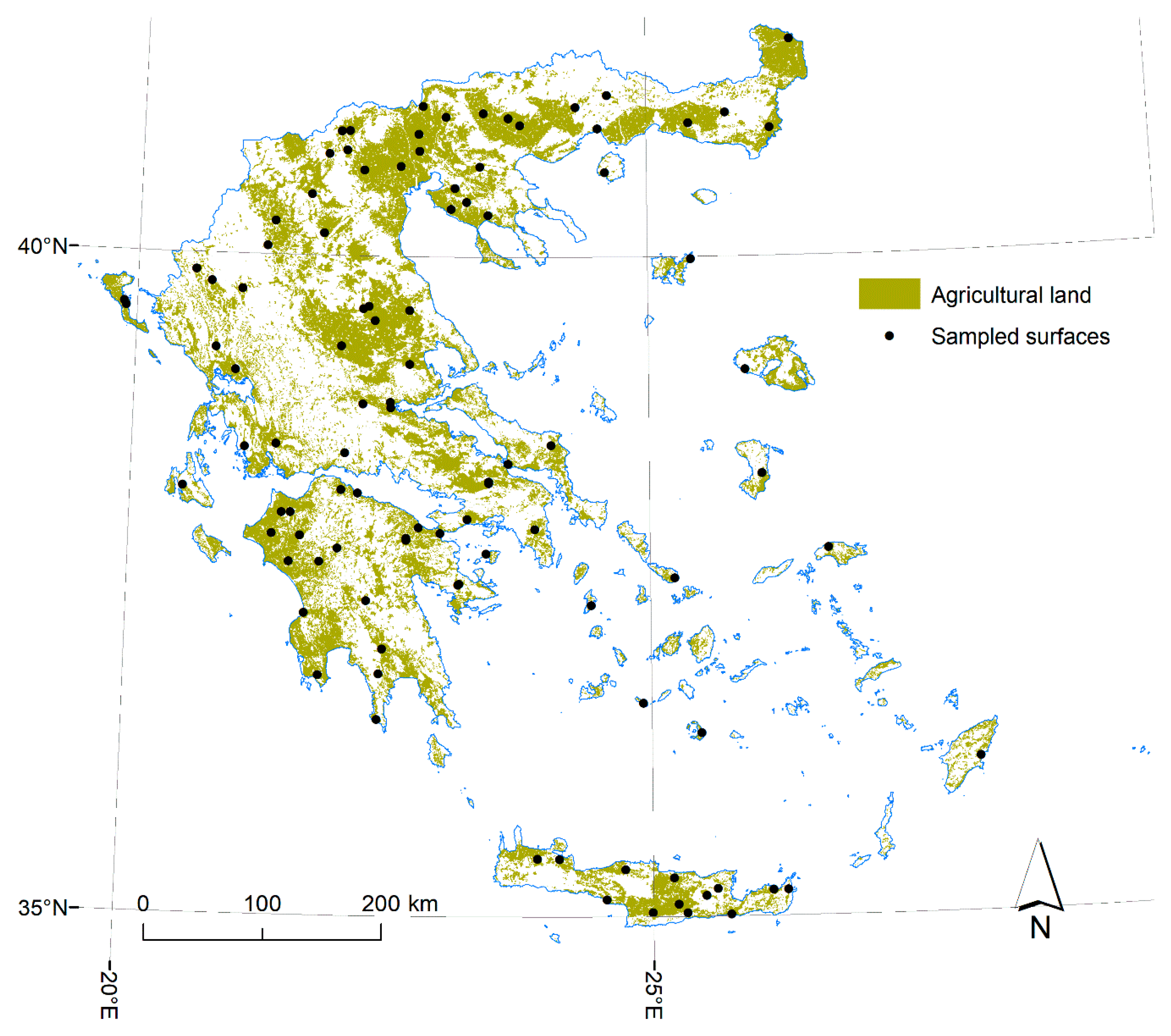
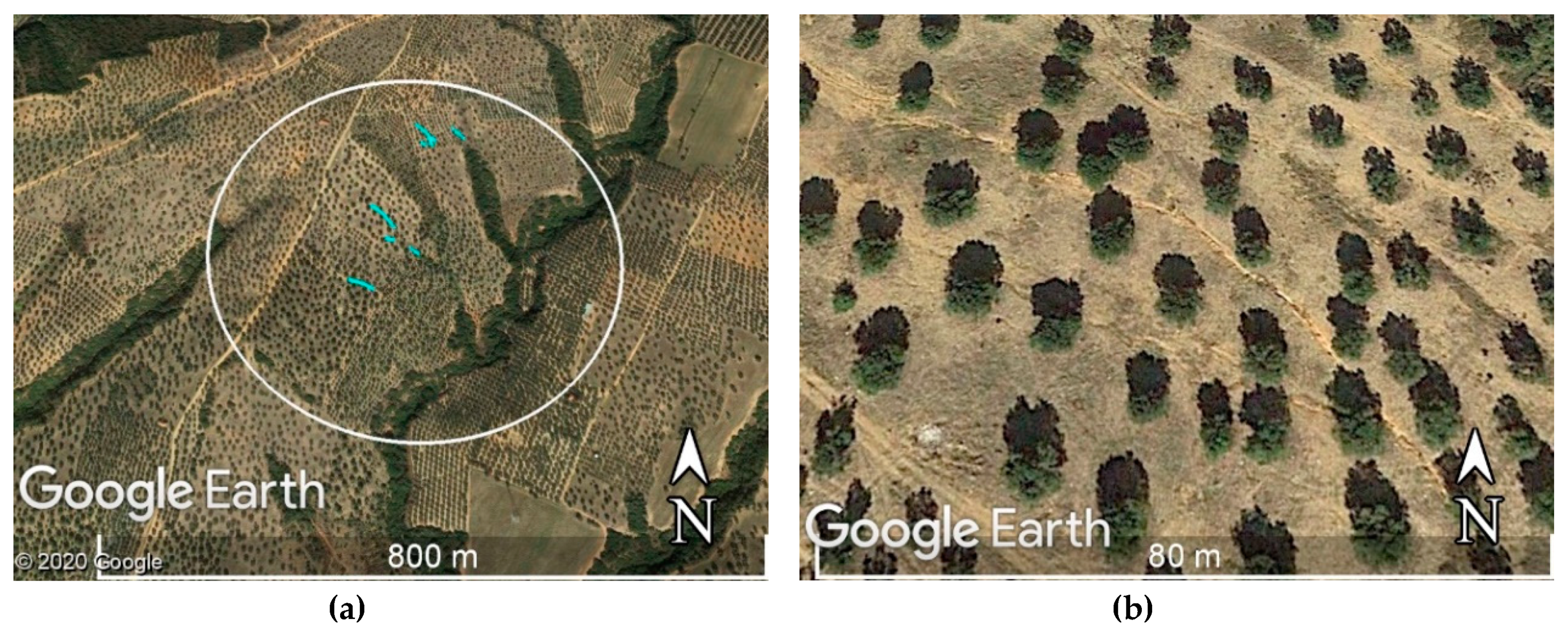
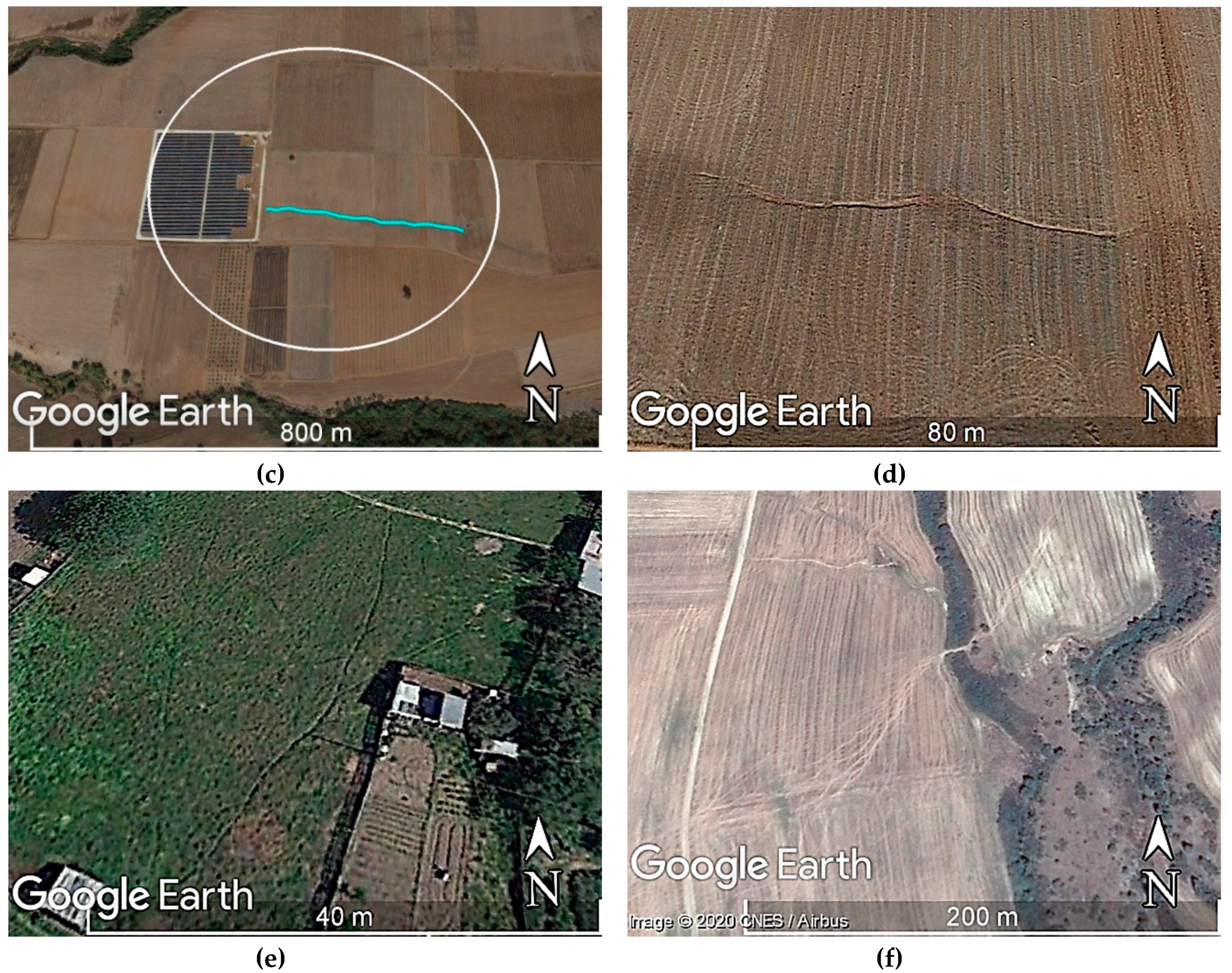
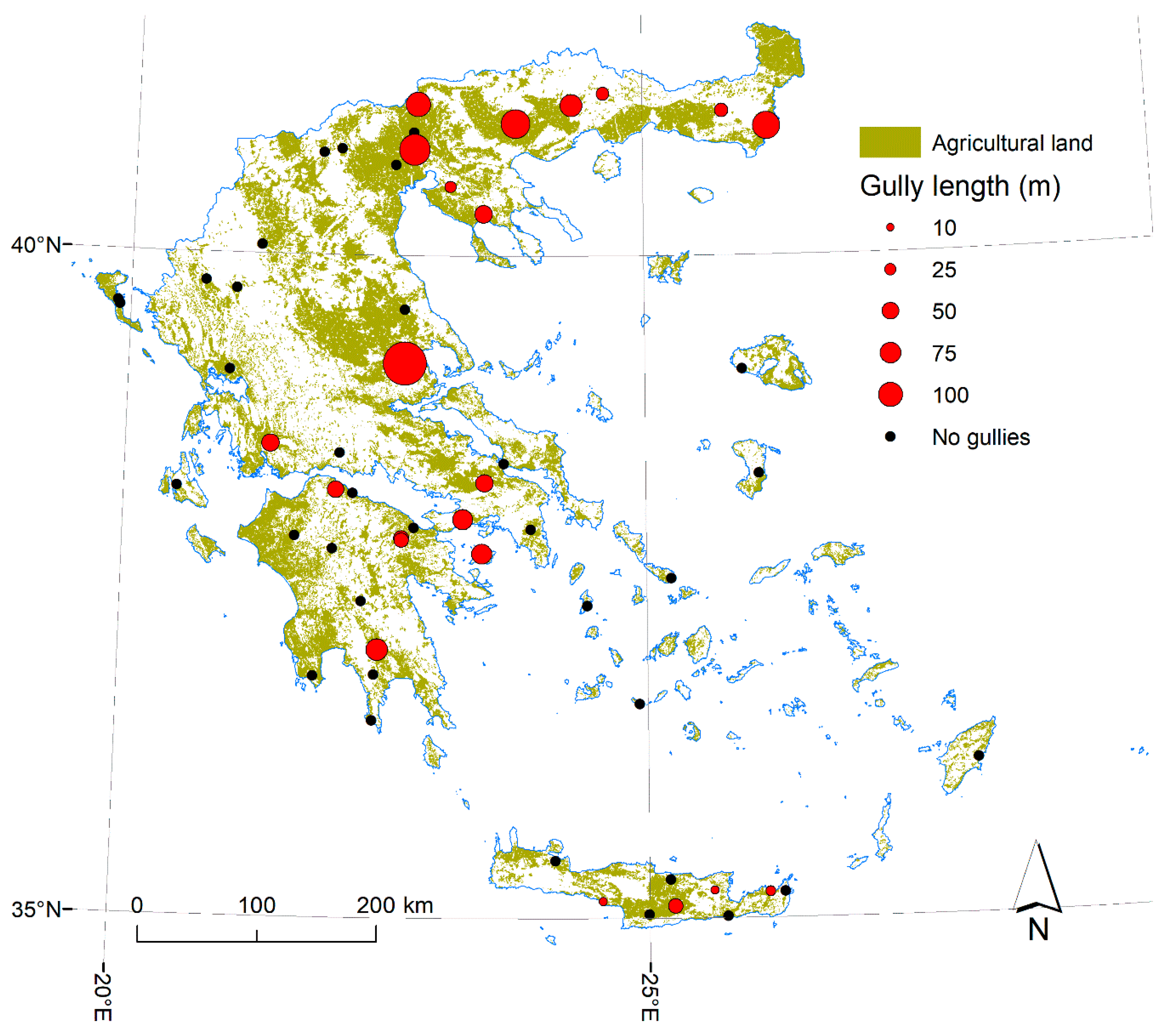
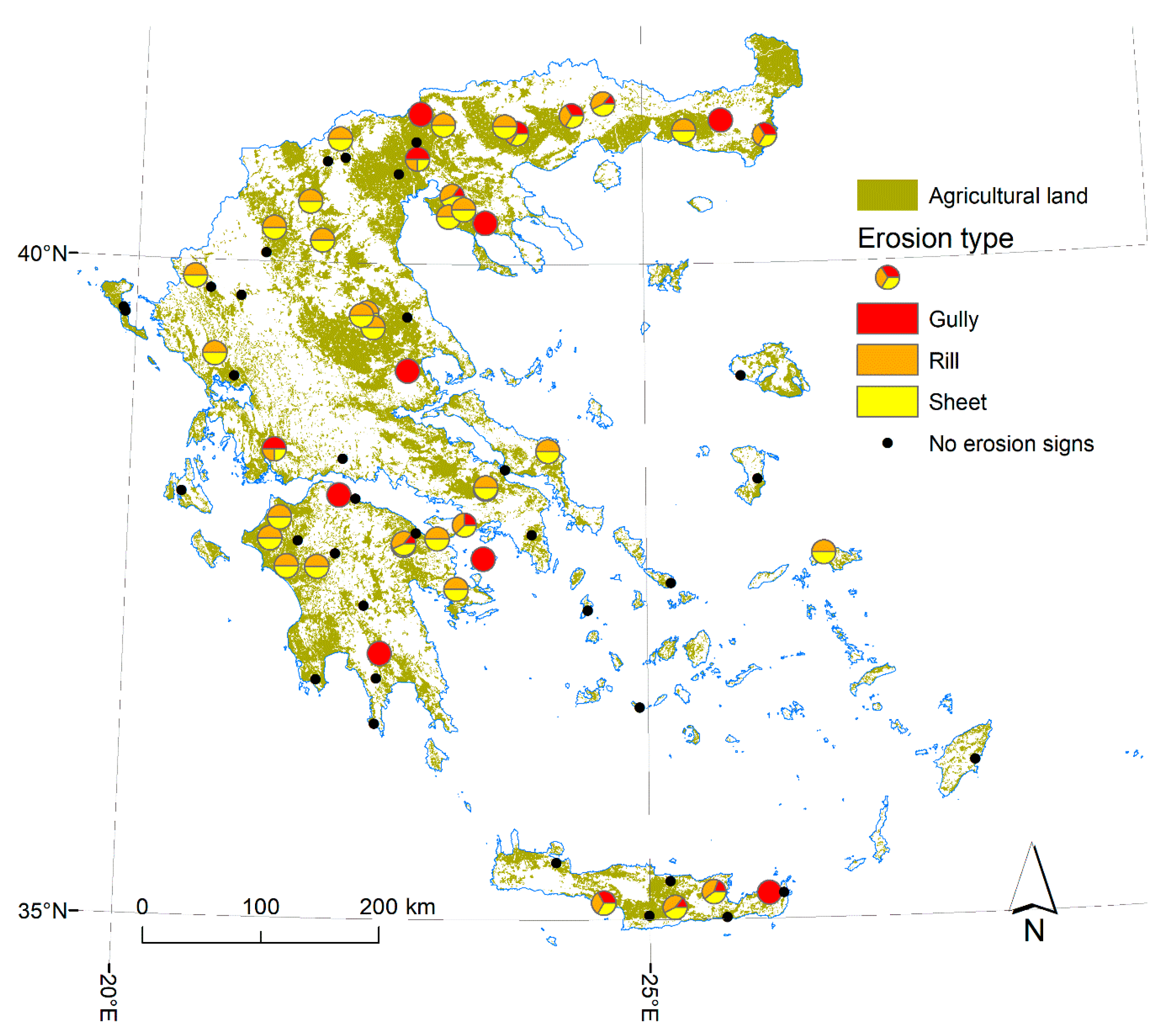
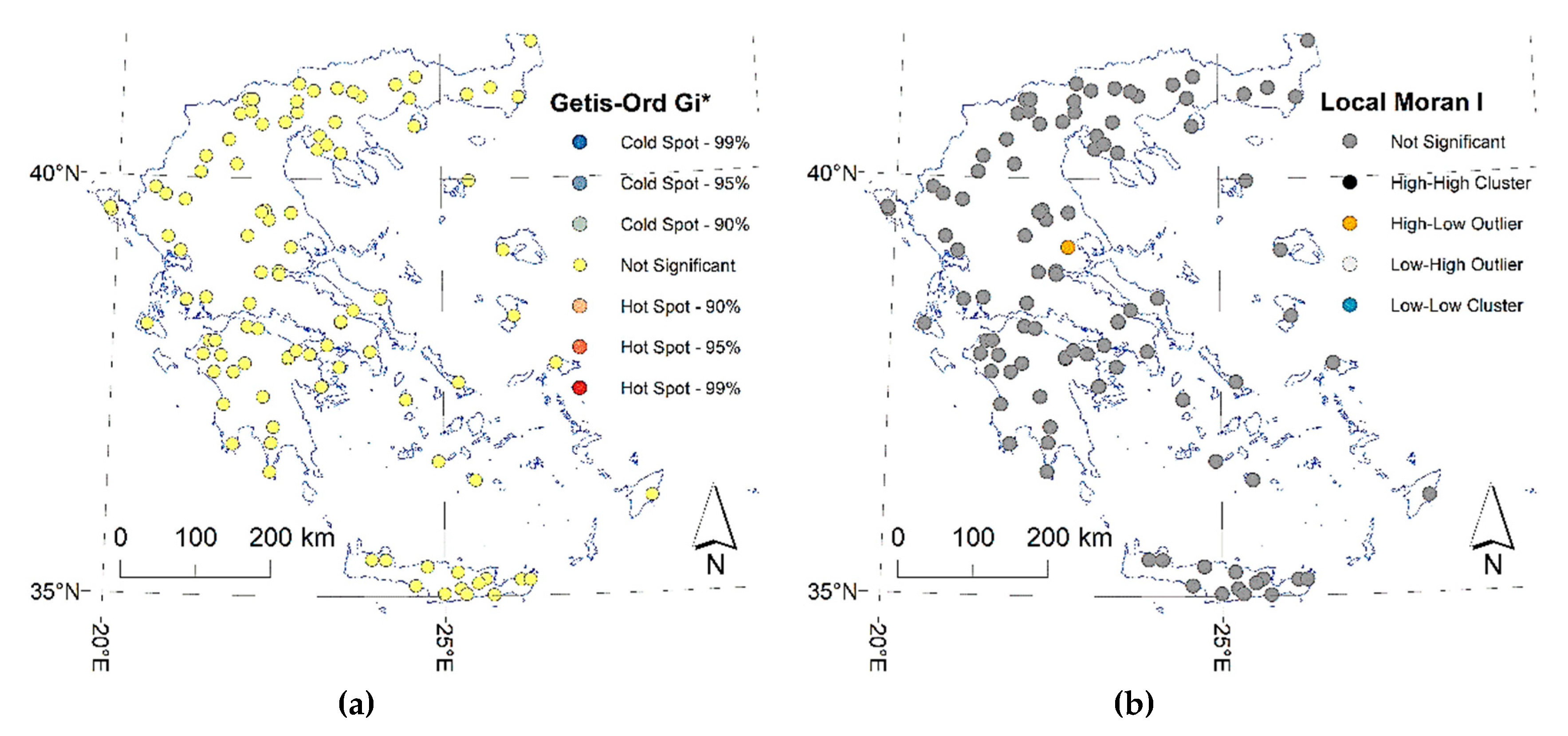

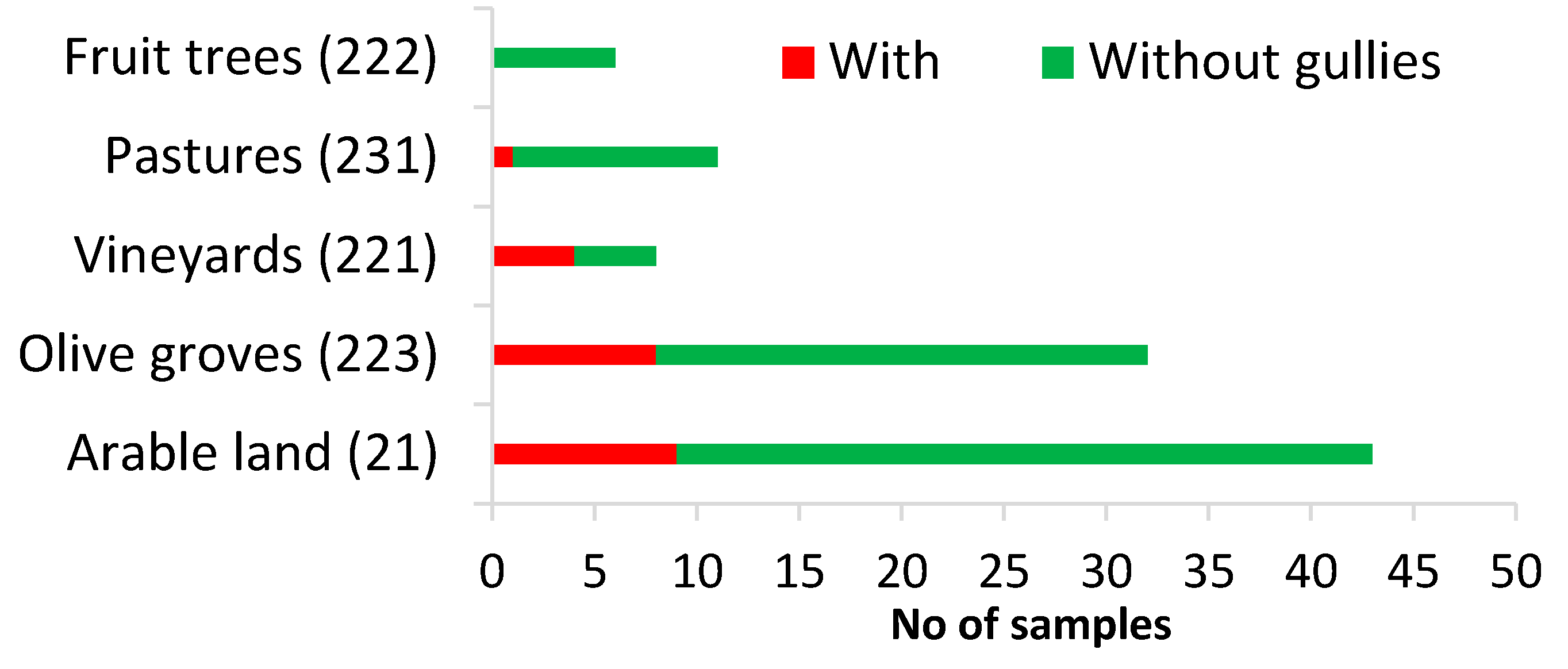
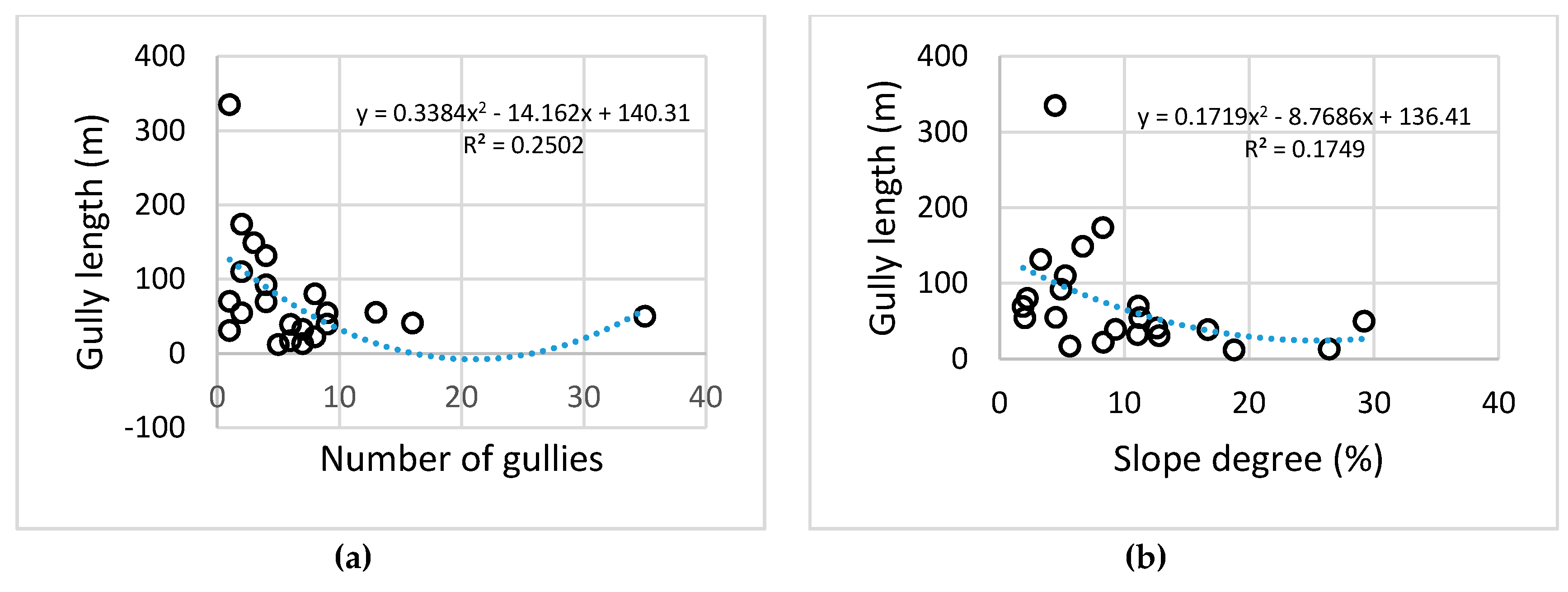
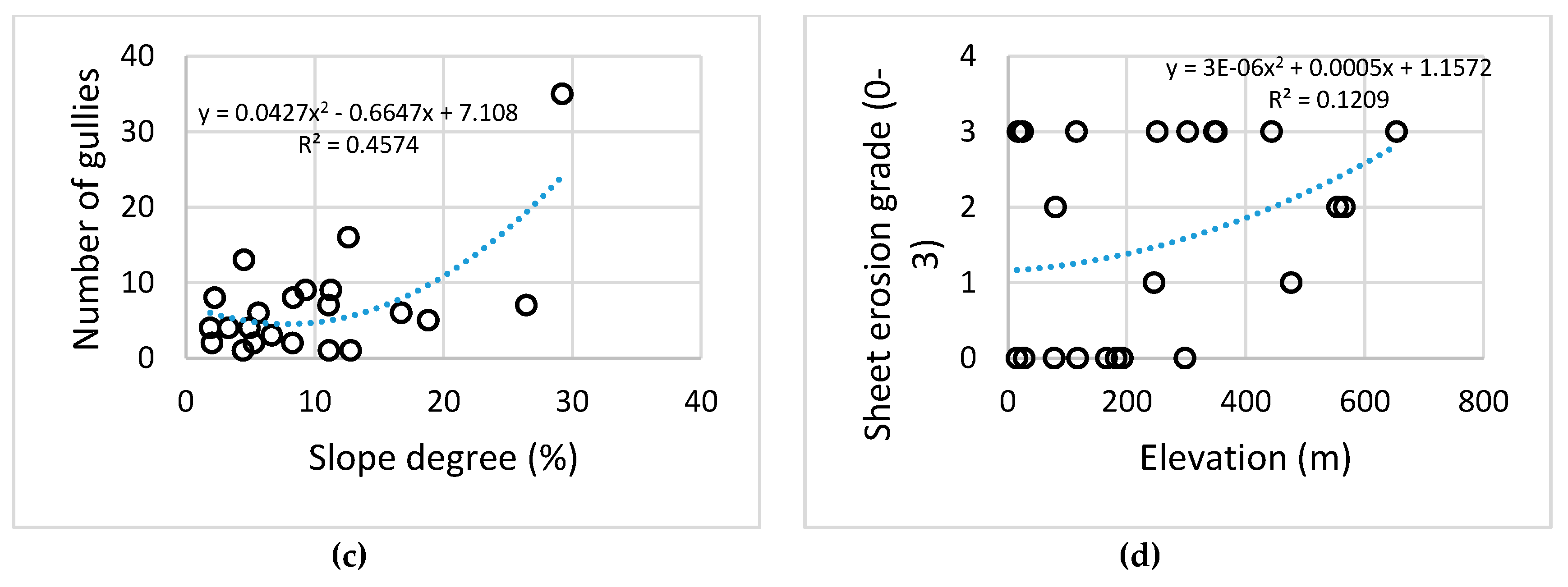
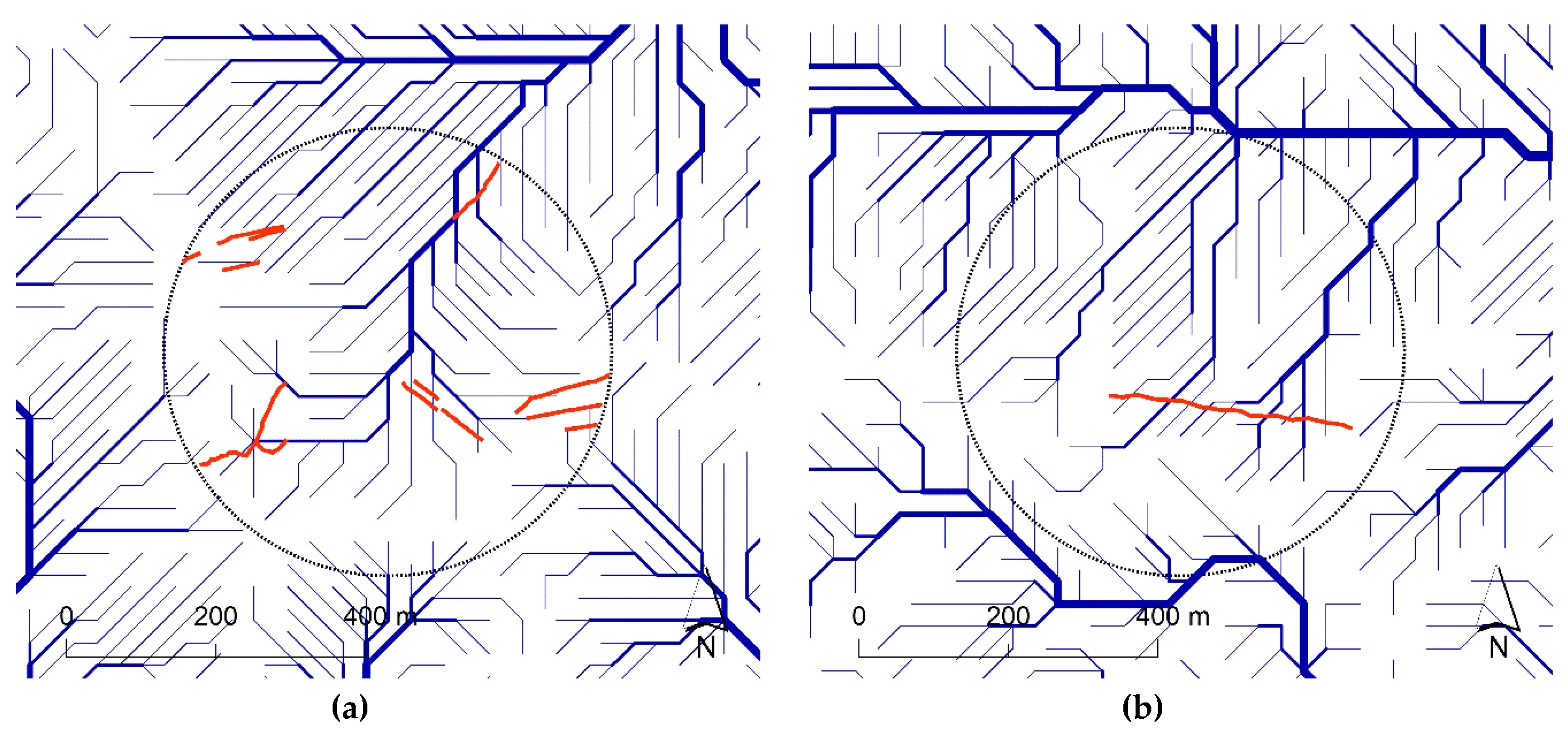
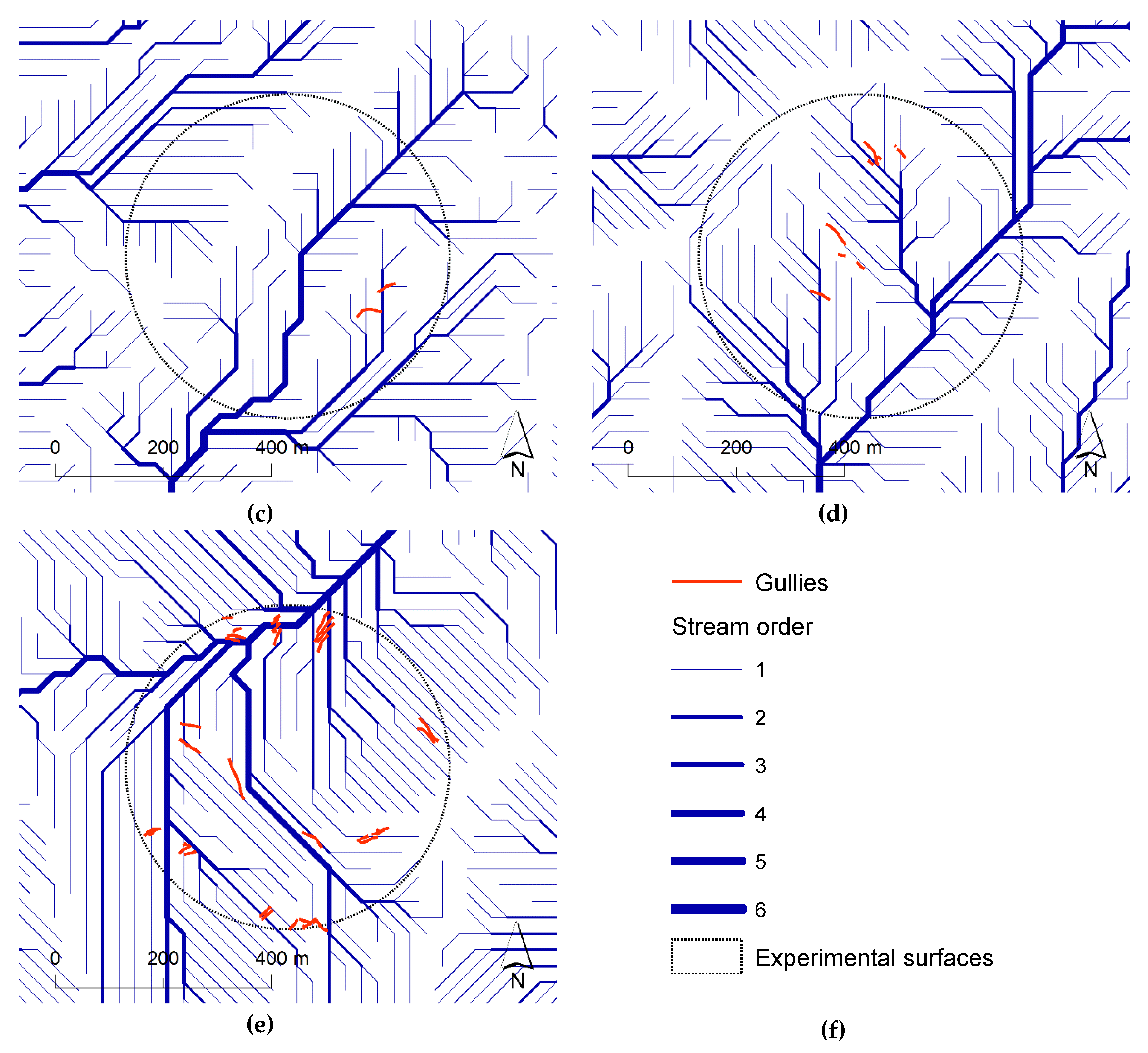
| Parameter | Arithmetic Figures |
|---|---|
| Samples with gullies | 22/100 |
| Number of gullies | 153 |
| Length of gullies | Mean = 55.6 m Min = 3.5 m Max = 379 m |
| Elevation of: Sampled surfaces Samples surfaces with gullies | 205.7 m (5 m–962 m) 201.3 m (14 m–568 m) |
| Slope of: Sampled surfaces Samples surfaces with gullies | 9.4% (0.2%–35.7%) 9.7% (1.8%–28.7%) |
| Signs of rills (total) Slight (1) Moderate (2) Strong (3) | 130/153 (85%) 108/153 (70%) 20/153 (13%) 2/153 (1.3%) |
| Signs of sheet erosion (total) Slight (1) Moderate (2) Strong (3) | 81/153 (53%) 7/153 (4.5%) 13/153 (8.5%) 61/153 (39%) |
| Land Use | G+T Samples * | Average Slope (%) | G-T Samples * | Average Slope (%) |
|---|---|---|---|---|
| Arable land | 0 | - | 9 | 6.5 |
| Olive groves | 4 | 13.9 | 4 | 12.3 |
| Vineyards | 1 | 12.6 | 3 | 10.8 |
| Pastures | 0 | - | 1 | 8.3 |
| Fruit trees | 0 | - | 0 | - |
| Overall | 5 | 13.6 | 17 | 8.7 |
© 2020 by the authors. Licensee MDPI, Basel, Switzerland. This article is an open access article distributed under the terms and conditions of the Creative Commons Attribution (CC BY) license (http://creativecommons.org/licenses/by/4.0/).
Share and Cite
Karydas, C.; Panagos, P. Towards an Assessment of the Ephemeral Gully Erosion Potential in Greece Using Google Earth. Water 2020, 12, 603. https://doi.org/10.3390/w12020603
Karydas C, Panagos P. Towards an Assessment of the Ephemeral Gully Erosion Potential in Greece Using Google Earth. Water. 2020; 12(2):603. https://doi.org/10.3390/w12020603
Chicago/Turabian StyleKarydas, Christos, and Panos Panagos. 2020. "Towards an Assessment of the Ephemeral Gully Erosion Potential in Greece Using Google Earth" Water 12, no. 2: 603. https://doi.org/10.3390/w12020603
APA StyleKarydas, C., & Panagos, P. (2020). Towards an Assessment of the Ephemeral Gully Erosion Potential in Greece Using Google Earth. Water, 12(2), 603. https://doi.org/10.3390/w12020603






